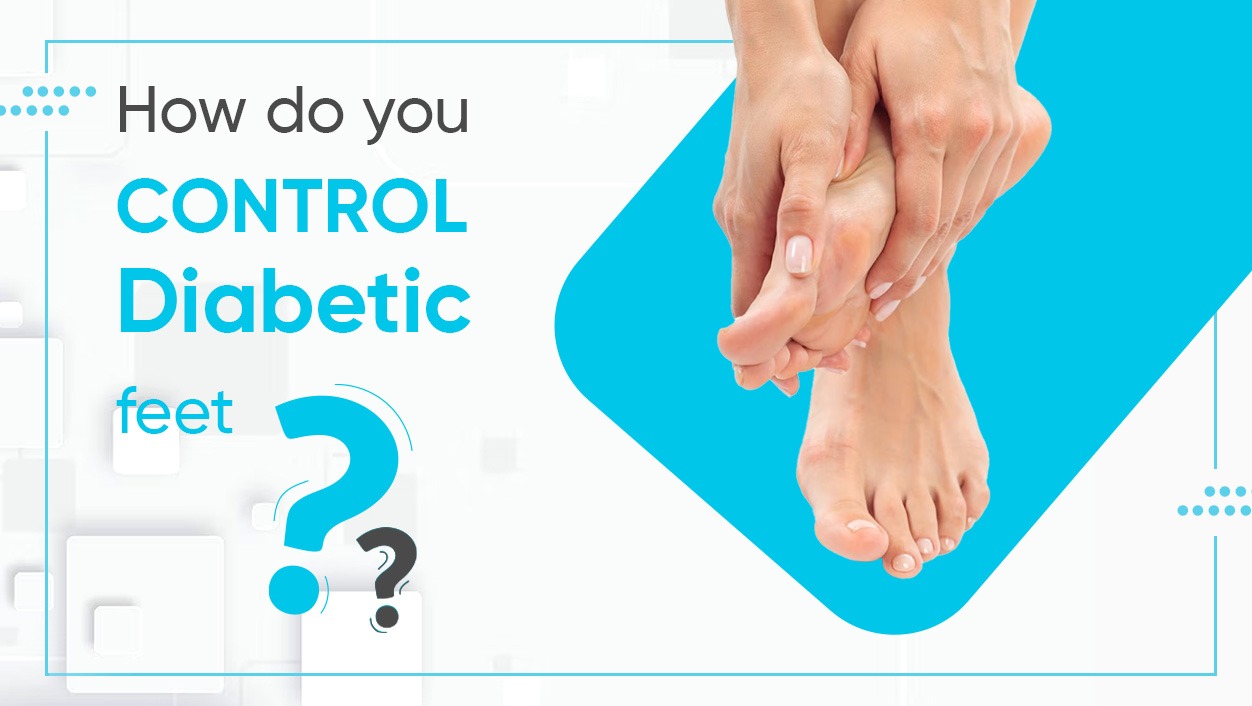How do you control diabetic feet?
Diabetes can cause consequences such as nerve damage, which usually affects the nerves in the legs and feet, resulting in a disease known as diabetic foot. A diabetic foot is a foot ulcer associated with neuropathy, infections, and ischemia.
Nearly 6% of people with diabetes have foot problems such as infections, ulcers, and tissue damage. According to the United Nations, a lower leg is amputated (removed) every 30 seconds due to diabetes somewhere in the world. Blood glucose Control, on the other hand, can prevent at least half of all diabetic leg amputations.
Diabetes, nerve degeneration, and poor blood flow are the two most common causes of foot problems. Diabetics can avoid developing ulcers or blisters on their feet by taking proper care of their feet.
A diabetic foot is caused by a number of things. Ulcers on the feet can develop for a variety of reasons, including the following:
Diabetic neuropathy: People who have had diabetes for a long period of time may develop neuropathy, which affects their ability to sense pain and temperature in their feet. As a result, the person is blind to the pain, blister, or ulcer that may form on the bottom of their foot as a result of friction, pressure, or stress.
Ischemia: It can cause an ulcer to occur as well as hinder the healing process.
Foot abnormalities: While walking in shoes, structural malformations in the foot, such as a bunion, can irritate the skin of the feet. It could trigger an ulcer in their feet. Shoes that don’t fit right: Shoes that don’t fit right might exert excessive strain on the feet and produce friction while walking, which can lead to ulcer formation.
Who is more likely to get a diabetic foot?
Diabetic feet can affect anyone diagnosed with diabetes. People who are at a higher risks of having a diabetic foot are
1.People who have had diabetes for a long time and rely on insulin to keep their blood sugar levels under control.
2.Individuals that are overweight
3.Those who drink alcohol and smoke cigarettes are known as alcoholics and tobacco smokers.
4.Diabetic patients with kidney, eye, or heart problems
5.People with vascular diseases like peripheral artery disease or deep vein thrombosis.
What are the symptoms and indicators of diabetes in the feet?
Pain is not a typical symptom of diabetic feet because most people have already lost their ability to feel it. Other signs and symptoms are:
1. On the socks, there is a small amount of liquid discharge.
2.Inflammation of the foot, including redness and swelling
3.Feet have a foul odor.
Is there a way to avoid diabetic feet?
According to the WHO, simple foot care can avoid at least half of all diabetic leg amputations. Simple precautions in daily hygiene practice can help prevent diabetic foot. Here are some suggestions:
1. Cuts, inflammation, redness, ulcers, corns, calluses, and blisters should all be looked for on a regular basis. Any change in the shape or color of the nails should be examined as well. Plantar warts or ulcers must be checked on the bottoms of the feet.
2.Using soap and warm water, wash the feet. Check to see if the water is warm. It is recommended that diabetics avoid immersing their feet in the water.
3.To reduce friction and infection, dry the feet fully with a soft towel and apply talcum powder. powder between the toes.
4.Apply a thick layer of lotion to the feet, avoiding the toes.
5.It’s best not to go barefoot when walking. To protect themselves from damage, diabetics must always wear socks, shoes, or slippers. Before putting on your shoes, Inspect the interior for any pebbles or sharp items.
6.To avoid developing ulcers, wear shoes that fit properly. At first, new shoes must be worn with socks for an hour or two until they are entirely comfortable.
7.Socks with more padding, no elastic tops, and a length that exceeds the ankle are recommended.
8.In the event of snow or rain, keep your feet dry. Change your socks as quickly as possible if they become filthy.
9.Straighten your toenails. Using a nail file, gradually smooth out all of the sharp edges.
10.Corns and calluses should not be removed with any over-the-counter product since they may cause skin irritation.
11.While sitting or standing in one spot for a long time, raise your feet or wiggle your toes for a few minutes to keep the blood circulating.
12.For at least 10 to 20 minutes per day, engage in foot-friendly activities such as walking, cycling, or swimming.
13.Keep a healthy blood sugar level since high blood sugar impairs the body’s capacity to fight infections and slows the healing process.
14.Smoking lowers blood flow to the extremities, including the feet, therefore giving up the habit.
15.Reduce sugar and salt consumption by including more fruits and vegetables in your diet.
When is it appropriate to seek medical advice?
If a diabetic develops ulcers or displays signs of infection or sepsis, he or she should see an endocrinologist or diabetologist as a way to get treatment. The following are signs that you should see a doctor right away:
1. In the feet, there is a tingling or burning sensation.
2. Leg pain
3. Cramps in the buttocks, thighs, or calves during exercising
4. Touch and temperature sensitivities are impaired.
5. The contour of your feet may change.
6. The skin on your feet is dry and cracking.
7. A fungus between the toes has caused a change in the skin’s colour.
8.Ingrown toenails, thick and yellow
9.On the foot, you may have an ulcer, blister, sore, or infected corn.
Takeaway:
Diabetes foot is a major diabetes condition that can lead to catastrophic complications if not addressed promptly. It can lead to the removal of the foot in the most severe cases. Maintaining good blood sugar control, monitoring the feet every day, wearing suitable footwear, and becoming aware of the dangers of developing a diabetic foot can all help prevent it.
Every time a diabetes patient visits the doctor, the doctor examines their foot for any pre-ulcerative lesions. Diabetics should have their peripheral neuropathy and peripheral arterial disease checked on a regular basis since they are more likely to develop ulcers.









